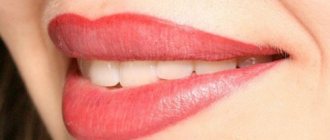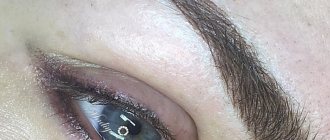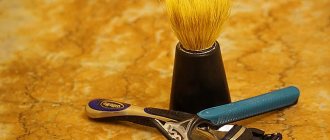- home
- Eyes
Permanent tattooing is a fashionable procedure for applying long-term makeup. It's beautiful and fashionable. Today, many women use the services of beauty salons to apply eyeliner on their eyelids. High quality work becomes a decoration for several years. The right arrows can highlight the eyes and add volume to the eyelashes. Unfortunately, not every woman is lucky, and many end up with inexperienced specialists. Due to lack of practice, you can end up with ugly makeup.
Why do you need tattoo removal?
Laser eye tattoo removal is performed for the following reasons:
- Features of the epidermis. In some cases, external factors or physiological characteristics of the body can lead to negative changes in shade. These include the external influence of UV rays, which contribute to the fading of paint, long-term use of certain medications, changes in hormonal levels, and metabolic disorders. A change in the original color with the appearance of a brown, reddish or gray undertone often becomes the reason for the removal of tattoos on the lips, eyebrows, and eyes.
- Change of image. If a hot brunette decides to change her look and become a blonde, the original shade of the tattoo requires color correction.
- Poor quality dye. If the artist used low-quality or weakly pigmented dyes, the result may be unexpected and require correction or complete removal.
- Changing shape. If the shape of the eyebrows turns out to be unsuccessful, has gone out of fashion, or is no longer suitable due to a change in image, the technique of complete or partial removal of the permanent is used.
- Emergence of voids. Due to injuries, skin regeneration or the use of certain aesthetic cosmetology techniques - peelings, deep mechanical cleansing, subcutaneous injection of various cosmetic preparations, voids may appear in the tattoo lines, requiring correction or complete removal of paint.
Since the main advantage of the technique is the duration of the effect, one of the reasons for elimination may be obsolescence and unaesthetic appearance.
In the cosmetology field, new tattooing techniques are being offered. Old techniques with deep subcutaneous injection of paint often look unnatural, changing over time the original color to shades of blue, brown or green.
Such a permanent is inferior in aesthetics to new technologies, so many people are dissatisfied with the appearance and want to make the image more natural with the help of new cosmetic techniques.
Indications for this procedure
Eye tattooing is suitable for girls in the following cases:
- The color of natural eyelashes is light, which is why they have to be constantly tinted with mascara. Thanks to the interlash technique, they will visually become darker.
- A woman has sparse eyelashes and wants to increase their thickness naturally.
- The client does not want to spend time every day applying makeup to the eyes.
- A female representative often finds herself in conditions in which ordinary makeup is washed off and loses its original appearance. Eye tattooing remains intact despite any external factors.
You may have your own reasons for doing permanent eyeliner makeup; if you wish, you can clarify them with a cosmetologist by attaching examples of work in the video so that he can do the chosen option.
Benefits of laser removal
Removing tattoos from the eyes with a laser, as well as from other areas of the face, is an innovative technology that has become available relatively recently. Before its invention, specialists resorted to overlapping color, sometimes using the wrong technology; as a result, the client could get 3 eyebrow lines located on top of each other.
Unaesthetic eyebrows and eye arrows were painted over with camouflage dyes. In modern industry, the laser method is one of the most effective, popular and safe technologies. The method allows you to gradually reduce the dye without visible negative consequences - crusts, scars, scars.
The main advantages of the laser tattoo removal technique include:
- the ability to remove dye without leaving a trace;
- absence of severe pain at the time of radiation exposure;
- low risk of injury with bleeding;
- safety, hypoallergenic, versatility;
- visible effect after 1 session;
- no risk of burns;
- stimulation of the growth of own hairs;
- maintaining the integrity of the skin;
- a minimum list of strict contraindications.
Photos before and after laser eye tattoo removal
To remove tattoos, specialists use several techniques, the most popular being laser technology, as well as the use of a remover - a special chemical composition that destroys the color.
Comparative characteristics of popular cosmetic methods are presented below:
| Latest generation neodymium laser | Professional remover | |
| Operating principle | The targeted beam breaks the pigment into small particles, which are removed through the lymphatic system. | The chemical components of the remover combine with pigment particles, forming a substance that pushes the paint to the surface of the skin and comes off with the crust of the epidermis. |
| Traumaticity | If the laser technology is followed, the skin will not be injured. | The chemical composition mechanically destroys the upper layer of the epidermis, which can lead to skin trauma. |
| Effect | The pigment brightens instantly and evenly, the final result is in 20-30 days. | The pigment may come out unevenly, the final result after complete healing, 30-40 days. |
During laser dye removal, no scars are left on the skin and hair follicles are not affected. This method is one of the best in the technique of permanent correction, allowing you to remove the paint to the effect of “clean” skin.
The method of correction or removal of pigment with a neodymium laser is noted by cosmetologists as minimally invasive, non-traumatic, and does not require long-term recovery.
Does it hurt to make arrows?
To find out about the presence of pain, just watch a video in which eye tattooing is done. By determining the client's reaction, you can find out whether the procedure hurts.
Thanks to the use of a high-quality anesthetic, the likelihood of pain during the session is reduced to a minimum. In order not to disturb this, follow the instructions of the master before the visit.
To ensure that the anesthesia used will prevent the risk of pain, check its certification before getting an eye tattoo.
If you have a low pain threshold, tell the specialist so that he can add more pain medication than prescribed.
If you have any unpleasant sensations during the work of the master, inform him about it, just don’t tolerate them. Tight eye muscles can prevent the dye from being injected correctly.
Disadvantages of laser removal
Modern methods of laser paint removal are versatile and effective.
Despite many advantages, aesthetic hardware technology has several disadvantages:
- the cost of the procedures is quite high;
- the effect requires several sessions, their number may depend on the depth of the dye;
- long interval between sessions;
- the neodymium laser procedure is often accompanied by pain;
- impossibility of tattoo removal if the injected pigment is close in color to the skin tone.
The technique is stated to be painless. Cosmetologists note that the sensation of pain may depend on individual characteristics and the area being treated. To prevent the sensation of pain, before removing a tattoo, the artist may offer application anesthesia.
Eyeliner with shading
This unusual option for shading the tattoo of the upper eyelid is not common, since clients usually prefer to use the standard techniques offered by the salon.
There are three types of tattooing that are performed in the upper eyelid area:
- Arrow. It is a popular type of tattoo because the line is standard upper eyelid makeup, which is often used by modern women in everyday life.
- Shading, or decorative makeup, in which the dye is applied in a dense layer at the eyelash line, and closer to the fold of the eyelid this layer becomes transparent. This overflow looks impressive in any case.
- Interlash tattoo, in which pigment is applied along the line between the eyelashes, emphasizing the border of the upper and lower eyelids. Thanks to this method, they visually look darker and longer.
Eyeliner shading is a combination of two techniques, which makes this method suitable for a wider range of clients because it has more positive aspects.
In what cases is it not carried out?
Laser eye tattoo removal is a modern technique with highly effective aesthetic results after just 1 session. Despite the hypoallergenicity, safety and low risk of complications, there are a number of contraindications to its implementation.
It is not recommended to use laser tattoo removal technology if the following contraindications exist:
- autoimmune disorders;
- for oncological tumors;
- hypertension, pathologies of the cardiovascular system;
- for skin pathologies, wounds and abrasions in the treated areas;
- blood diseases and low coagulability;
- for infectious diseases, herpes infection;
- HIV AIDS;
- For allergic diseases;
- with diabetes mellitus in the stage of decompensation;
- with a tendency to keloid scarring.
A categorical contraindication is during pregnancy and lactation. You should not use the laser pigment removal technique before the age of 18, during the period of exacerbation of chronic diseases, acute respiratory viral infections, burns, wounds, or on the skin after sunbathing.
Failure to comply with contraindications can cause serious damage to the body or increase the risk of developing negative side effects.
Stages of applying permanent eye makeup
Steps for creating an arrow tattoo:
- After arriving at the salon, you will be placed on a couch and your head will be fixed in one position. Then they will remove all makeup and degrease the skin of the eyelids. To do this, use a cotton pad soaked in micellar water. It is better to remove makeup in advance or not wear makeup in the morning.
- Discuss with the master the appropriate color scheme of the arrows, style, and tell us about your wishes. To apply the sketch, use an eye tattoo pencil; if necessary, the drawing is adjusted. In the end, you will get the option that you like best.
- After discussion and preparatory procedures, an anesthetic is applied to the eyelids. Typically a gel or ointment, thinner formulations can get into the white of the eye and leave a chemical burn.
- Now we begin to apply the eye tattoo. The first line of treatment is the eyelash growth contour. Then the treatment area is increased and arrows are drawn. If you need to do shading, the specialist creates the appearance of spraying by introducing pigment into different points of the skin.
- Having completed the first stage of work, the cosmetologist washes off the previously drawn sketch. If necessary, shortcomings are eliminated.
- While the machine for tattooing arrows on the eyes is in progress, the needles are constantly changing. The skin around the eyes is blotted with a sterile napkin, the visible lymph, blood and excess pigment are removed.
- Twenty minutes after the permanent arrows are applied, secondary anesthesia is applied to the skin. It prolongs the analgesic effect.
Although the product used is lidocaine, pain may occur.
The skin of the eyelids is thin and sensitive. Some people experience watery eyes due to unpleasant sensations during the tattoo procedure, while others only feel a slight tingling sensation on top of the eyeball.
What determines the effectiveness of the procedure?
Laser pigment removal technology is one of the most effective methods in aesthetic cosmetology.
Several types of laser are used for procedures for removing subcutaneous pigment:
- Ruby. The device allows you to effectively display “complex” colors - red, crimson, yellow, green.
- Erbium. Based on the principle of photomechanical reaction, it acts delicately and is used to remove superficial patterns with weak pigmentation.
- Alexandrite. Suitable for working with faded tattoos, the beam is not able to destroy the bright pigment.
- Carbon dioxide. The beam is able to penetrate deep layers, removing dye of any type and color. The disadvantage of the device is the high risk of injury with long-term rehabilitation.
- Neodymium. The modern, most versatile device is capable of removing any pigment at different depths of the skin layers.
The choice of the type of equipment, as well as the depth and intensity of the beam’s impact on the subcutaneous layers is determined by the cosmetologist after assessing the condition of the skin and the nature of the introduced pigment.
There are also a number of other determining factors that can affect the final aesthetic result:
- Individual client request and method of initial pigment application. If, at the client’s request, the effect needs to be made less noticeable, 1 procedure will be required. If the pigment was introduced using the hair technique, it is easier to remove than a solid line with maximum color filling.
- Type of equipment . The neodymium laser pigment removal technique is universal, safe and effective.
- Type of dye . The pigment based on metal oxide is removed from under the skin quite slowly. After laser exposure, the contours may noticeably darken. If the pigment is made with the addition of iron dioxide, after correction the eyebrow shade may change to grayish-brown.
- Insertion depth. The beam acts on the surface of the epidermis. If the tattoo was done too deeply, several sessions will be required until, layer by layer, the pigment is completely destroyed.
- Color . The darker and more saturated the tone, the easier it is to destroy it with a beam. The beam does not affect light colors close to the skin tone. Crimson, yellow, green and red shades are also difficult to remove. If the composition includes tattoo ink, the laser also has little effect on it. Black and dark brown colors are best removed.
One of the factors influencing the effectiveness of the procedure is the initial skin tone. It has been noted that in patients with dark skin, the laser is less effective than in those with fair skin. Dark skin attracts the rays more strongly and scatters them, preventing the removal of the dye.
Eye tattoo pigments
As you know, when creating a tattoo, the pigment is injected directly under the skin. Correctly selected dyes with the required level of quality are the key to achieving excellent results.
Today, there is a wide selection of all kinds of pigments. An experienced master does not just work with one of them, he mixes several options to achieve the most harmonious effect.
For example, to reduce the tint of blue, green, or black dye, a certain color is added. This leads to a chemical reaction that produces the desired tone. The same manipulations are carried out with brown color.
As a rule, experienced craftsmen prefer to use pigments from American manufacturers.
They have a number of advantages:
- are quickly fixed without spreading over the surface of the eyelid;
- allow you to get clear arrows;
- contain a color stabilizer;
- the composition is of mineral origin, which practically reduces the likelihood of an allergic reaction;
- the pigment contains a fixative, which eliminates the need for the artist to add additional chemical components to the paint.
Preparing the skin for tattoo removal
At the preparatory stage, the cosmetologist conducts a consultation, during which he talks about the features of the procedure, its advantages and risks. Before the session, it is important to identify whether there are contraindications in order to avoid negative consequences for the body in the future.
Laser exposure is often painful, it all depends on individual susceptibility. Therefore, immediately before the session, an application anesthetic - ointment or gel - is applied to sensitive areas.
To increase efficiency and reduce the risk of side effects, it is important to follow the preparation rules:
- Before the session and between all subsequent sessions, exposure to the open sun is excluded. Exposure to UV rays increases the degree of sensitivity to the laser.
- Within a few days, you need to stop smoking, taking medications, and applying cosmetics that affect the condition of the skin.
- It is recommended to postpone the session if there are abrasions, open wounds, burns, until complete healing.
If immunity is reduced due to a long-term illness, there is an increased body temperature, signs of colds, the procedure should be postponed.
Features of eye care after eye tattooing
When permanent eye makeup has already been created, all that remains is to properly take care of your own face during the not too long recovery period.
After the procedure you can observe:
- swelling;
- redness of the eyes;
- the appearance of crusts;
- itching;
- bruising if the needle penetrates the capillaries.
Following all the recommendations given by the masters allows you to get rid of unpleasant moments within two to three weeks.
Features of care:
- for the first 2 weeks, tanning, baths, saunas, bathing, applying makeup, using cleansing cosmetics, and forced removal of crusts are prohibited;
- The affected area is treated with an antiseptic 2 times a day, followed by application of a healing composition (for example, Panthenol);
- To disinfect the mucous membrane of the eyes, use eye drops recommended by the specialist.
Primary tattooing requires correction a month after the main procedure. Subsequently, you need to come for these manipulations once every 1.5 – 3 years.
How does a laser remove tattoos?
Tattoo removal of eyebrows, lips or eyes is carried out with a neodymium device - a new generation laser, which is noted as the safest and most effective device operating by the method of selective photo-cavitation.
This technology allows you to remove the dye without a trace, but this effect requires several sessions. The essence of radiation exposure is the use of ultra-powerful pulses in the picosecond range.
The principle is as follows:
- to remove the dye from the epidermal layers, nano-flares are produced, 3-5 nanoseconds each;
- beam penetration deep into the epidermal layer reaches 5 mm;
- the targeted action allows you to bypass the structural protein of collagen and elastin without affecting water and melanin;
- upon reaching the paint layer, the beam splits it into tiny particles, which are naturally excreted by the lymphatic system.
Laser tattoo removal technology follows a single algorithm:
- An anesthetic cream is applied to the treated areas. The cosmetologist adjusts the device to the required power; the selected mode depends on the type of skin, its condition, and the characteristics of the tattoo.
- Safety glasses are put on the eyes, after which the specialist conducts a test to determine the skin's reaction to laser exposure. If there is no negative reaction, the cosmetologist begins to treat the entire area.
- After the procedure, the treated areas are soothed with ice cubes to relieve swelling, and an anti-inflammatory agent is applied.
The main advantage of the method is its effectiveness and safety. The beam acts directly on the dye molecules without damaging the tissue, without the risk of thermal burns and changes in the structure of the hair.
The final stage of the session is consulting a specialist on further measures - the rules of the rehabilitation period and calculating the interval of subsequent treatments for 100% results.
What does it look like
With the competent work of a cosmetologist, the result looks neat. At first it may seem too dark, too bright. This side effect goes away after a recovery period (1 month), and is due to the fact that the paint has not had time to be absorbed at this time.
Evaluate what the effect of the chosen technique looks like in a video or photograph in order to imagine what you will ultimately see before your eyes.
The effect looks natural in life, in photos and videos. At the same time, the video is a clear indicator of the master’s work, since the video reflects reality with virtually no changes.
How many sessions will be needed?
During laser exposure, painful sensations are possible, especially in sensitive areas. Before the procedure, it is recommended to numb the area with a special anesthetic cream. To obtain 100% effect with complete lightening of the pigmented area, 3-10 sessions may be required. The number of procedures is prescribed by the cosmetologist.
The duration of the course depends on several factors:
- the desired effect (complete removal of the dye or its lightening);
- type, initial state of the epidermis;
- composition and shade of paint;
- pigment layers;
- laser treatment method.
The interval between sessions can be 3-5 weeks. The number of sessions and the optimal interval between them is determined by a specialist after the first procedure. This allows you to evaluate how easily the paint can be removed and evaluate the skin’s reaction to laser exposure.
After each treatment, time is required for rehabilitation, after which the effect can be assessed. Complete removal of tattoos using a laser device can take up to 2 years.
Recovery period, possible complications
Laser pigment removal technology is safe and low-traumatic. In some cases, complications may arise due to incorrect selection of the laser and the intensity of its action, as well as due to non-compliance with the procedure protocol.
Of the following nature:
- swelling, erythema of the treated area;
- the appearance of burns, hematomas, scars;
- pigmentation;
- development of allergies and inflammation.
You need to know that the device is equipped with a metal handpiece, so the appearance of a small hematoma, slight swelling and redness is normal.
All standard negative manifestations quickly pass if you follow the rules of post-procedure care, namely:
- Avoid exposure to open sun and apply a product with a high protection factor before going out.
- Avoid drinking alcohol, smoking, avoid going to the bathhouse, solarium, swimming pool,
- Avoid using decorative cosmetics and skin care products containing alcohol or aggressive chemical components.
- Treat with wound healing agents for 5-7 days.
- If crusts form, do not pick them off.
To minimize the healing time, cosmetologists recommend limiting minor mechanical impact on the treated areas, as well as applying Bepanten ointment, before washing the skin with baby soap and blotting with a towel.
Correct removal of unsuccessful or annoying tattoos of eyebrows, eyes or lips with a laser allows you to restore aesthetics to your image. To achieve the desired result and eliminate the risk of complications, the procedure must be carried out by a highly qualified specialist using certified equipment.
When is the best time to tattoo your eyelids?
Like other types of micropigmentation, tattooing of the interlash space and arrows is an invasive procedure. During the session, the skin is pierced with a needle from a manipulator or tattoo machine, and microscopic particles of pigment are introduced inside. Mechanical damage to the epidermis and the body’s allergic response to foreign components of the pigment lead to the appearance of edema. It takes time for it to come down.
To reduce the negative impact of the procedure on the body, you need to carefully select the time for the micropigmentation session. Here are some conditions:
- There should be a day off on the day of the procedure and the next 24 hours after it. A person who has undergone tattooing will almost certainly not be able to start working immediately. And you shouldn’t appear in public with swollen eyelids and scabs. Most often people plan to visit a beauty salon during the holidays.
- You should not plan the procedure if you have health problems: colds, exacerbations of herpes and skin infections, stomach problems or other inflammatory processes in the body. Make an appointment with a specialist when there are no health problems.
An important point: pregnant women are allowed to undergo the procedure no earlier than the third trimester. Most gynecologists and cosmetology specialists recommend postponing tattooing for a while and signing up for the procedure after pregnancy and breastfeeding.
- After micropigmentation, you are not allowed to visit the pool, sauna, or beach. Therefore, if you plan to go to the sea on your vacation, you should not make an appointment with a cosmetologist for a tattoo.











